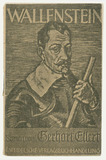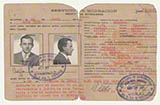Bodo Uhse: Lieutenant Bertram, book cover (1944)
Bodo Uhse: Lieutenant Bertram, book cover (1944)
LIEUTENANT BERTRAM is a richly-detailed revelation of the German people – not in the mass, or as a types, but as individuals who, whether Nazis or anti-Nazis, are alive, and as real in their passions and peculiarities as our next-door neighbors.
The publishing house Simon & Schuster on Lieutenant Bertram, 1944
In 1944 the New York publishers Simon & Schuster released the American edition of Bodo Uhse's novel Leutnant Bertram under the title Lieutenant Bertram. A novel of the Nazi Luftwaffe, translated by Catherine Hutter. The novel was first published in German in 1943 by El Libro Libre, the Mexican exile publishing house. The New York contract had been arranged by F.C. Weiskopf, a writer who had fled to the United States.
Uhse had worked for eight years on Lieutenant Bertram, starting to write it while in exile in Paris in 1935 and completing it in Mexico. It describes the transition of a Wehrmacht pilot officer from a supporter to a critic of the German aggression. The novel provided an elaborate representation of society: from German officers and soldiers through to workers and resistance fighters.
In the United States in particular there was great interest in such material towards the end of the war. It put faces to the people behind the front line. The publisher stressed in the accompanying advertising copy that the author had detailed knowledge of the German Luftwaffe. Uhse, son of an imperial officer, had indeed received military training during his own membership of the Nazi party (1927-1929). As a reporter and as political commissar of two divisions he had experienced the struggles in Spain in 1937 on the republican side in the Spanish civil war, the setting for the second part of the novel, Auf fremder Erde.




